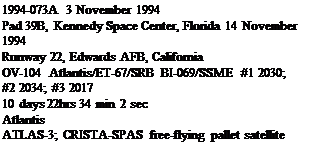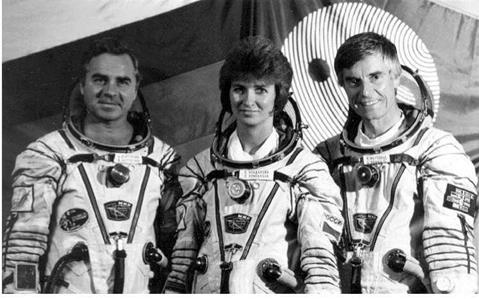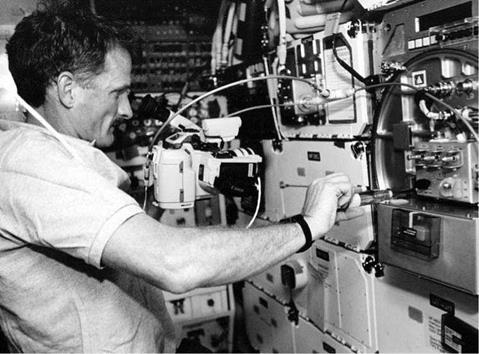. SOYUZ TM20
Flight Crew
VIKTORENKO, Alexandr Stepanovich, 47, Russian Air Force, commander, 4th mission
Previous missions: Soyuz TM3 (1987); Soyuz TM8 (1989); Soyuz TM14 (1992) KONDAKOVA, Yelena Vladimirovna, 37, civilian, flight engineer MERBOLD, Ulf Dietrich, 53, civilian, ESA research engineer, 3rd mission Previous missions: STS-9 (1983); STS-42 (1992)
Flight Log
As Soyuz TM20 approached Mir’s docking port on automatic, it yawed to the side, forcing Viktorenko to take manual control to complete the docking without further incident. Aboard the Soyuz was Shuttle veteran and ESA astronaut Ulf Merbold, who would be staying aboard the station for a month to operate the EuroMir94 experiment programme. Hastily assembled (and underfunded by ESA), the experiment programme was heavily dependent upon equipment left aboard Mir during earlier international visits by Austrian, French and German cosmonauts, and on the facilities of the station itself. The experiment programme featured 30 experiments: 23 in life sciences, 4 in materials sciences and 3 in technology. Merbold’s mission was a precursor to the planned 135-day EuroMir95 mission scheduled for the following year, and for operations on the ESA Columbus module that was planned for ISS. A fault on the Kristallisator furnace prevented Merbold from performing his materials experiments. The replacement would not arrive at the station until after Merbold had returned to Earth.
With six cosmonauts on Mir for a month, the drain on resources was beginning to tell. On 1 October, during the recharging of Soyuz TM20’s batteries, TV equipment could not be recharged at the same time. A short circuit on the computer that oriented
|
The crew of Soyuz TM20 included ESA astronaut Merbold (right) and Russian cosmonaut Viktorenko (left). In the centre is Kondakova, only the third Russian female to fly in space since the manned programme began in 1961. |
the solar arrays to face the Sun meant that the station was unable to replenish its power and the batteries had drained. This necessitated the use of reaction control propellant on the Soyuz TM in order to realign the station, point the arrays at the Sun and restore power via a back-up computer. These interruptions affected Merbold’s science programme, which had to be adjusted around the periods of lost power. On 3 November, the EO-16 crew and Merbold boarded Soyuz TM19 to test the Kurs docking system. TM19 undocked and backed away from the station to 190 metres, then successfully re-docked automatically and the crew re-entered the station for 24 hours. Had the docking failed then the crew would have completed an emergency return to Earth. In the event, a nominal landing was achieved the following day. Merbold returned with 16 kg of life science samples he had collected during his month on the station. The collection included 125 saliva, 85 urine and 34 blood samples.
When Progress M25 arrived on 13 November, it delivered spares for the furnace, which allowed the experiments planned for Merbold’s visit to be completed.
By 18 November, the Mir base block had completed 50,000 orbits of Earth since its launch in February 1986. For a while, it looked as though Viktorenko and Polyakov would have to perform EVAs in late November, to move the Kristall arrays in preparation for the arrival of the Spektr module in December. However, that launch soon slipped (in part due to the Americans’ late shipping of equipment and Russian customs bureaucracy) and the EVAs were cancelled.
On 9 January 1995, Polyakov set a new single-mission endurance record of one year and one day, and with over 600 days to his credit from two missions, he was already by far the most experienced space traveller with another three months to go in the flight. Given the uncertainties over the safety of flying such a long mission, and his potential exposure to ambient radiation, Polyakov slept in the Kristall module shielded by the batteries, in order to avoid putting his colleagues at any undue risk. Viktorenko and Kondakova occupied the two individual cabins in the base block. On 11 January, in order to review repairs to the Kurs system, the cosmonauts conducted another test, undocking TM20 and pulling back 160 meters before completing a successful automatic re-docking. A month later, a new spacecraft arrived at Mir, but this one would not be docking. One of the objectives of US Shuttle Discovery’s STS-63 mission was to test launch and rendezvous windows for the later docking missions. For a few hours on 6 February, Discovery flew in close proximity to Mir, approaching to approximately 10 meters in a simulated docking approach. This was the closest that a manned Russian and American spacecraft had been to each other in space since ASTP in July 1975. After a photographic fly-around exercise, Discovery departed to continue its own mission, leaving Mir’s cosmonauts to resume preparations for their return to Earth.
After Norman Thagard arrived with the next resident crew on Soyuz TM21 on 16 March 1995 and the period of hand-over operations were completed, the EO-17 crew of Viktorenko and Kondakova returned to Earth on 22 March, along with Polyakov. The latter had set a single-mission record of 438 days, which is unlikely to be surpassed for decades. Indeed, there are no plans to try to surpass it for the foreseeable future. Despite such a long flight, the doctor-cosmonaut insisted in walking unaided to the medical tent once he was helped from the Descent Module. Polyakov had performed over 1,000 tests in a programme of 50 medical experiments, losing 15 per cent of his bone density. This took a few months to regain, and even then the recovery was not total. This was despite a strict regime of two hours exercise per day which he observed strictly every day in space. The loss of oxygen-bearing red blood cells in the early weeks of his flight was countered by adjusting Mir’s environmental control system, but the soles of his feet had softened as he had not “walked” for several months. He had proved that a flight of 14 months was possible (a duration which could support a manned round trip mission to Mars), but at a cost. Polyakov’s bravery and determination to complete both the exercise programme and the flight stand out as one of the milestones in manned space flight history, one whose legacy will only really be seen when the first crews are dispatched towards Mars.
Milestones
174th manned space flight 79th Russian manned space flight 20th Manned Mir mission 17th Mir resident crew 72nd manned Soyuz flight 19th manned Soyuz TM flight
1st female cosmonaut assigned to a long-duration mission Longest single space flight by a female (Kondakova)
Polyakov sets a new world record for one flight of 437 days 17hrs and a career record in two space flights of 678 days 16hrs

 |
Flight Crew
McMONAGLE, Donald Ray, 42, USAF, commander, 3rd mission Previous missions: STS-39 (1991); STS-54 (1993)
BROWN Jr., Curtis Lee, 38, USAF, pilot, 2nd mission Previous mission: STS-47 (1992)
OCHOA, Ellen Lauri, 36, civilian, mission specialist 1, payload commander, 2nd mission
Previous mission: MS STS-56 (1993)
TANNER, Joseph Richard, 44, civilian, mission specialist 2 CLERVOY, Jean-Francois Andre, 35, civilian, ESA mission specialist 3 PARAZYNSKI, Scott Edward, 33, civilian, mission specialist 4
Flight Log
This was the third flight of the same seven-instrument ATLAS payload that had previously flown on STS-45 in 1992 and STS-56 in 1993, making this one of the most comprehensive efforts to gather data about the energy output of our Sun and the chemical make-up of Earth’s atmosphere. The six astronauts would operate a two – shift system. McMonagle would lead the Red Shift, with Ochoa and Tanner, while Brown, Clervoy and Parazynski worked the Blue Shift.
The only slight delay to the launch of STS-66 was caused by weather conditions at the transoceanic abort sites. Atlantis was on its first mission since returning from the Rockwell Palmdale facility, where it had received new nose wheel steering capability, improved internal plumbing and electrical connections that would allow the EDO pallet kit to be fitted when required. Additional electrical wiring was also installed in preparation for fitting the Orbiter Docking System for the first Shuttle-Mir docking missions, which Atlantis was manifested to fly in the summer of 1995.
ATLAS-3’s Atmospheric Trace Molecule Spectrometer (ATMOS) collected more data on trace gases in our atmosphere on this flight than on its previous flights
|
Joe Tanner works among several lockers on the mid-deck of Atlantis during the Atlas 3 mission. While the payload in the cargo bay was being operated, the crew members worked on secondary experiments. Here, Tanner works with protein crystal growth support equipment that represents continued research into the structures of proteins and other macro-molecules such as viruses. Such work never usually made the headlines during these missions but it was as important as the major payload, helping to develop understanding and experience of operating small scientific experiments and hardware in space as a prelude to ISS |
combined. The Shuttle Backscatter UV Spectrometer recorded ozone measurements which were used to calibrate the ozone monitor on the ageing NOAA-9 satellite. The Active Cavity Radiometer Irradiance Monitor (ACRIM) that obtained precise measurements of the Sun’s total radiation for 30 orbits (about 1,350 minutes) was also used to calibrate another spacecraft, the UARS satellite. Other instruments recorded measurements of the Sun in the various radiation categories. Before a malfunction shut down the Millimeter Wave Atmospheric Sounder (MAS), it collected nine hours of data on water vapour, chlorine, carbon monoxide and ozone in Earth’s atmosphere at altitudes of 20-100 km.
The Cryogenic Infrared Spectrometers and Telescopes for the Atmosphere – Shuttle Pallet Satellite (CRISTA-SPAS) was a second primary payload and was classed as a joined mission with ATLAS-3 with a single set of scientific objectives. Released by RMS on FD 2, it flew behind Atlantis at a distance of about 40-70 km, collecting data for over eight days on the medium – and small-scale distribution of trace gases in the middle atmosphere. The instruments on CRISTA-SPAS also recorded the amounts of hydroxyl and nitric acid that destroy the ozone in the middle atmosphere and lower thermosphere from 40 to 120 km. This represented the first complete global mapping of hydroxyl in our atmosphere, and helped to define a more detailed model and understanding of how energy is balanced throughout the layers.
When the satellite was retrieved and stowed in the payload bay prior to entry, the astronauts adopted the R-Bar rendezvous approach, which was the same as the one that would be used in the upcoming Shuttle-Mir missions, saving propellant and reducing the risk of contamination from thrusters’ jets. For this approach, the active spacecraft (in this case, Atlantis) approaches its passive target (CRISTA-SPAS) by flying along an imaginary line (bar) aligned with the radius (R) of the Earth. Approaching from “above” is called a “negative R-Bar’’ but the approach from below (used on STS-66 and for Shuttle-Mir), known as “positive R-Bar’’, depends upon the differential gravity from vertical separation to act as a brake and slow down the rate of closure. At the end of the STS-66 mission, Atlantis was diverted to a landing at Edwards because of high winds, rain and cloud cover at the Cape caused by tropical storm Gordon.
Milestones
175th manned space flight
96th US manned space flight
66th Shuttle mission
13th flight of OV-1094 Atlantis
3rd and final flight of ATLAS payload












